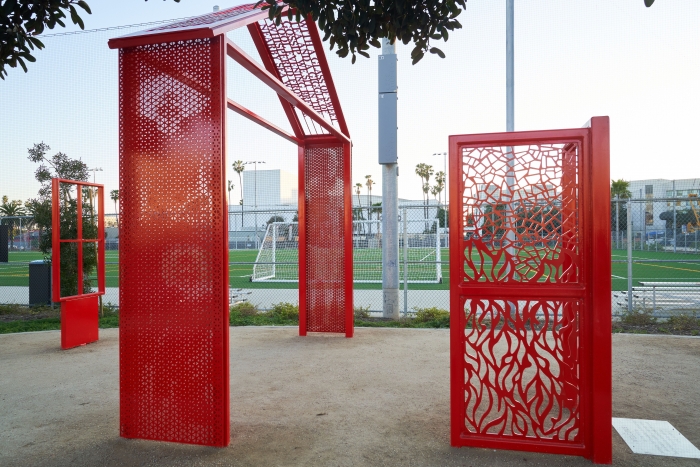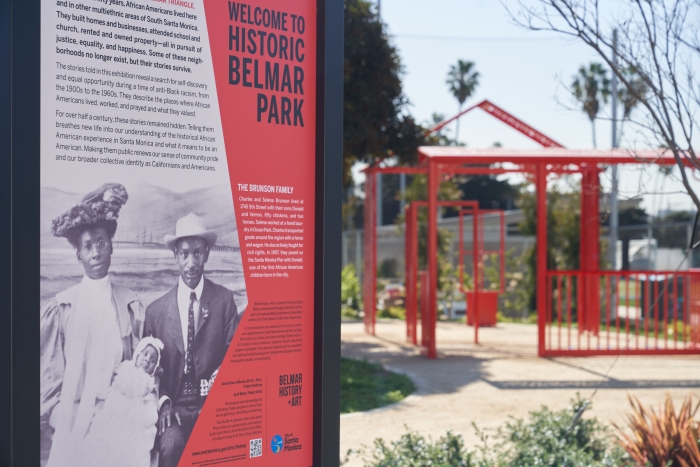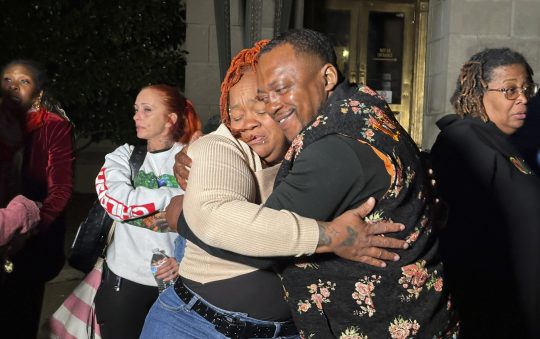
Nearly two months ago, the city of Santa Monica unveiled its latest open space area, the Historic Belmar Park. As the exhibition stands, it educates natives to Santa Monica and visitors of the historic roots that lie in Black culture and community.
History would tell, from the 1880s Black as Black families migrated from the South escaping blatant racism and then Jim Crow, many chose California due to the climate, advertisements regarding employment, healthcare, and overall beautiful life. Many of these Black families landed in Santa Monica beach neighborhoods, including Belmar Park, in clusters, being some of the first to settle in a beach neighborhood.
Black families lived in Santa Monica’s Belmar Park area until around 1950 when the city is said to have gone up in flames due to gentrification. What used to be a powerful Black community, then stood what is now the expanded Civic Center. It’s reported nearly 80 percent of those displaced due to the changes were Black or Brown as the city prepared itself to “clean up” impoverished areas to create a more “economically viable” area.

Now, located in that same area, Belmar’s History + Art Project that stretches the city’s park system provides a space for reflection and education. The new park showcases an outdoor exhibition, including an art installation created by April Banks titled, “A Resurrection in Four Stanzas.” There are also historical panels created by historian Dr. Alison Rose Jefferson.
Shannon Daut, manager of Cultural Affairs for the City of Santa Monica proposed the project as a means of community engagement through art. Bringing in Dr. Jefferson, artist April Banks, and a community advisory committee, Daut’s goals were to develop a program that uplifted and embraced the community. A project created during a time of present-day civil unrest, the Belmar History + Art Project could be seen as a restorative measure in the city’s history. “Now that the project has been completed, I have had to look back and think about all that we were able to accomplish in such a short time, during a very difficult year. In a way, it feels like the work has just begun,” Banks shared in a statement.
“We really embraced this, this condition that the Coastal Commission put in place and really see it now as a springboard for us to continue doing this work because there’s such a rich history of African Americans in Santa Monica and many people didn’t know about it. Belmar History + Art really gave us an opportunity to uplift this and really shine a light on both the issues of displacement, as well as celebrating all of the people that made this the city what it is today,” Daut stated.
Understanding the power of art, Banks speaks to her work, “The sculpture will take on a new life as people visit it and experience it from their own perspectives. I hope the community will use the sculpture as a place of reflection, storytelling and learning. I hope that the visibility of the piece encourages more families connected to this history to share their stories and that the historical record will continue to grow. And even though the time capsule is hidden away until 2070, it feels in a way, one of the most poignant parts of the art piece. It is a community vault, a repository, a talisman against future erasures.”
Daut shares that the community has also embraced the project, “Especially our Black community is very glad that this story is finally being told,” she shared. “I think art has the power to start conversations. We were nine months into the project when the civil unrest happened on May 31, [2020] here in Santa Monica around George Floyd’s death. There was a moment where I was watching the coverage of what was going on and I saw a car being burned in the Civic Center parking lot which is the place where these homes were literally burned down in the 50s.” She tells the feeling was a punch to the gut as she noticed how little we have come since the civil rights movement.

Author of the book Living the California Dream: African American Leisure Sites during the Jim Crow Era, Dr. Jefferson, who had been doing this research for years for several purposes, says her role as a historian was to connect the dots. “This is not a public art project in its totality, this is a public history project which has an art component,” she says. Dr. Jefferson affirms that there is more work to be done, much of which she has her hands in but this is a great step forward in cementing the history of Black residents in California across the beach neighborhoods.
Fellow historian, Robbie Jones also contributed to the creation of such an honorable moment in history. She tells as a native and current resident of Santa Monica, this public installment is about acknowledgment, restoration and healing for the Black community.
“The Belmar History + Art project is one of the many projects that reveal our African American history in Santa Monica. As a business owner and local historian, I often wonder what my Black Santa Monica Tours and Concierge experience, “Growing up Santa Monica” would be like if there was still a Belmar community. I am very pleased that, with the installation of the multipurpose field, there are history and art components to view and not just a plaque. Historic Belmar Park is both an amazing history and art experience and also just fun to explore. In my opinion this was a courageous move from the City of Santa Monica Cultural Affairs Division to commemorate the history of the families of the Belmar area in this way. I am fortunate to be one of the community members chosen to be a part of the team that helped see through fruition this amazing piece of American history.”
For more information visit santamonica.gov/arts/belmar. The Belmar History + Art Project is also open to the public and can be viewed during park hours or watch the grand opening via YouTube at https://www.youtube.com/watch?v=Js4Mu5RZzvg.
Updated 6/21/21 by Sentinel News Service







